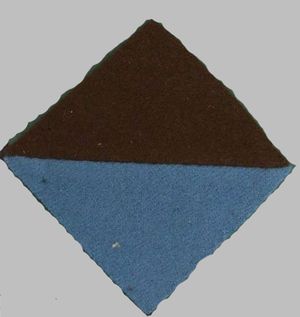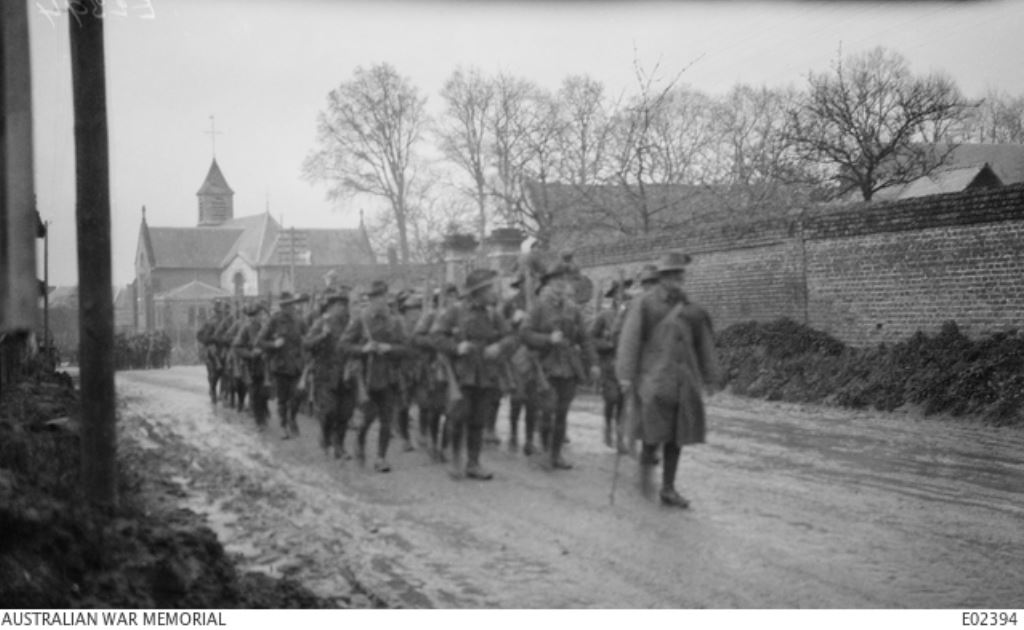Difference between revisions of "27th Battalion"
From Our Contribution
(Created page with "{{Infobox | name = 27th Battalion | title = 27th Battalion | above = | subheader = | image = 300px | c...") |
(→Battalion Personnel) |
||
| Line 36: | Line 36: | ||
===Battalion Personnel=== | ===Battalion Personnel=== | ||
* [[Arthur James Allen]] | * [[Arthur James Allen]] | ||
| − | * [[John Esperance Blair | + | * [[John Esperance Blair]] |
* [[Wilfred Norman Robinson]] | * [[Wilfred Norman Robinson]] | ||
Revision as of 14:26, 26 February 2021
 Shoulder patch | |
 5 Apr 1918. 27th Bn members marching south from Flanders to Dernancourt to relieve troops in the line. AWM photo E02394 | |
Contents
[hide]Brief History
As part of the 2nd Division, the 27th Battalion was formed on 16 March 1915 at Ascot Park Camp, Adelaide, from recruits drawn mainly from South Australia, who had originally been allocated to the 24th Battalion. After a period of basic training, the battalion embarked for the Middle East on the troopship HMAT A2 Geelong on 31 May 1915, arriving there on 6 July 1915.
They then undertook a further two months of training in Egypt before an urgent request for reinforcements led to them being dispatched to Gallipoli where they landed on 12 September.
Attached to the 7th Brigade, along with the 25th, 26th and 28th Battalions, they reinforced the New Zealand and Australian Division and took up a defensive position on Cheshire Ridge. After this they moved to new positions in Mule Gulley where they undertook further defensive operations alongside the 26th Battalion.
Amongst the first Australian troops to arrive in France, the 27th Battalion entered the front-line for the first time on 7 April 1916 as the Australians took over a quiet sector near Armentières. On 8 July 1916, the 7th Brigade was ordered to the Somme to support the Australian 1st Division which was taking part in the fighting around Poziéres. On 28 July, the 7th Brigade undertook an attack on the German line, however, during this time the 27th Battalion was held back in reserve. The attack proved unsuccessful and as a result the Brigade was ordered to launch a second attack on 4 August, centered upon German positions around Bapaume.
This time the 27th Battalion was to play a key role. Moving off from positions around La Boiselle in the afternoon, the battalion advanced with two companies forward and two back in reserve under the cover of an intense artillery barrage. Due to congestion around the assembly trenches, the battalion arrived at its objective late. Nevertheless, the first wave managed to capture the first line of German trenches and although the follow-up waves became lost amidst thick smoke, the two assault companies began to consolidate their position during the night. In the early morning of 5 August, a heavy German counterattack was launched. This was turned back with considerable cost, with the Germans suffering an estimated 100 men killed and 60 men captured. Later during the day the Australian positions were subjected to heavy shellfire from German guns positioned around Thiepval. This attack proved costly with the battalion reporting the following casualties: 40 killed, 289 wounded and 67 missing.
In January 1917, the 7th Brigade moved into the Le Sars sector where they took over offensive operations that during this time were largely curtailed by bad weather, but on 2 March the battalions of the 5th and 7th Brigades launched a combined attack north of Warlencourt.
The battalion's next engagement came on 26 March 1917 when they undertook an attack on Lagnicourt, during which they lost 11 killed and 29 wounded. The 27th Battalion did not undertake another major engagement until 20 September when they took part in the Battle of Menin Road. Later, they successfully took part in the Battle of Broodseinde on 4 October, and this was their last major offensive action in 1917.
The 27th Battalion returned to the battlefields of the Somme, as the 7th Brigade relieved the 13th Brigade around the Somme Canal on the night of 7/8 Apr 1918. At the end of the month they moved to the Camon–Rivery area. As the German offensive became focused upon Villers–Bretonneux they were called upon to undertake a supporting role to the Australian counterattack, relieving the 6th Brigade around Ville-sur-Ancre following the 6th's assault on the town.
On 8 August 1918, the Allies launched their Hundred Days Offensive. During the fighting around Amiens, the battalion was responsible for capturing 200 prisoners as well as a number of machine guns and artillery pieces. They remained in the line throughout August and September, undertaking further attacks at Biaches and Mont St Quentin. Casualties during this time were high and by the end of September 1918 the battalion's strength had fallen to 31 officers and 537 men. Their final engagement of the war came on the night of 3 October 1918, when they took part in the Battle of Beaurevoir.
The battalion suffered 762 men killed or died on active service during the war, as well as a further 2,155 wounded. The battalion was disbanded on 4 June 1919.
Battalion Personnel
Battle Honours
- Gallipoli 1915–16
- Somme 1916–18
- Poziéres
- Bapaume 1917
- Ypres 1917
- Menin Road
- Polygon Wood
- Broodseinde
- Poelcappelle
- Passchendaele
- Amiens
- Albert 1918
- Mont St Quentin
- Hindenburg Line
- Beaurevoir
- France and Flanders 1916–18.
Individual Honours
- 1 Companion of the Order of St Michael and St George (CMG)
- 5 Distinguished Service Orders (DSOs)
- 20 Military Crosses (MCs) and two bars
- 14 Distinguished Conduct Medals (DCMs)
- 69 Military Medals (MMs) and two bars
- 5 Meritorious Service Medals (MSMs)
- 21 Mentioned in Despatches (MIDs) and
- 6 foreign awards
Notes
Content for the history and honours sections has come from a combination of Wikipedia and the Australian War Memorial websites.